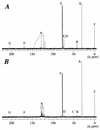Use of 13C nuclear magnetic resonance to assess fossil fuel biodegradation: fate of [1-13C]acenaphthene in creosote polycyclic aromatic compound mixtures degraded by bacteria
- PMID: 9546181
- PMCID: PMC106168
- DOI: 10.1128/AEM.64.4.1447-1453.1998
Use of 13C nuclear magnetic resonance to assess fossil fuel biodegradation: fate of [1-13C]acenaphthene in creosote polycyclic aromatic compound mixtures degraded by bacteria
Abstract
[1-13C]acenaphthene, a tracer compound with a nuclear magnetic resonance (NMR)-active nucleus at the C-1 position, has been employed in conjunction with a standard broad-band-decoupled 13C-NMR spectroscopy technique to study the biodegradation of acenaphthene by various bacterial cultures degrading aromatic hydrocarbons of creosote. Site-specific labeling at the benzylic position of acenaphthene allows 13C-NMR detection of chemical changes due to initial oxidations catalyzed by bacterial enzymes of aromatic hydrocarbon catabolism. Biodegradation of [1-13C]acenaphthene in the presence of naphthalene or creosote polycyclic aromatic compounds (PACs) was examined with an undefined mixed bacterial culture (established by enrichment on creosote PACs) and with isolates of individual naphthalene- and phenanthrene-degrading strains from this culture. From 13C-NMR spectra of extractable materials obtained in time course biodegradation experiments under optimized conditions, a number of signals were assigned to accumulated products such as 1-acenaphthenol, 1-acenaphthenone, acenaphthene-1,2-diol and naphthalene 1,8-dicarboxylic acid, formed by benzylic oxidation of acenaphthene and subsequent reactions. Limited degradation of acenaphthene could be attributed to its oxidation by naphthalene 1,2-dioxygenase or related dioxygenases, indicative of certain limitations of the undefined mixed culture with respect to acenaphthene catabolism. Coinoculation of the mixed culture with cells of acenaphthene-grown strain Pseudomonas sp. strain A2279 mitigated the accumulation of partial transformation products and resulted in more complete degradation of acenaphthene. This study demonstrates the value of the stable isotope labeling approach and its ability to reveal incomplete mineralization even when as little as 2 to 3% of the substrate is incompletely oxidized, yielding products of partial transformation. The approach outlined may prove useful in assessing bioremediation performance.
Figures



Similar articles
-
Evidence of polycyclic aromatic hydrocarbon biodegradation in a contaminated aquifer by combined application of in situ and laboratory microcosms using (13)C-labelled target compounds.Water Res. 2015 Feb 1;69:100-109. doi: 10.1016/j.watres.2014.10.045. Epub 2014 Nov 8. Water Res. 2015. PMID: 25437342
-
Bacterial community dynamics and polycyclic aromatic hydrocarbon degradation during bioremediation of heavily creosote-contaminated soil.Appl Environ Microbiol. 2005 Nov;71(11):7008-18. doi: 10.1128/AEM.71.11.7008-7018.2005. Appl Environ Microbiol. 2005. PMID: 16269736 Free PMC article.
-
Actions of a versatile fluorene-degrading bacterial isolate on polycyclic aromatic compounds.Appl Environ Microbiol. 1995 Oct;61(10):3711-23. doi: 10.1128/aem.61.10.3711-3723.1995. Appl Environ Microbiol. 1995. PMID: 7487007 Free PMC article.
-
Fossil fuel biodegradation: laboratory studies.Environ Health Perspect. 1995 Jun;103 Suppl 5(Suppl 5):79-83. doi: 10.1289/ehp.95103s479. Environ Health Perspect. 1995. PMID: 8565917 Free PMC article. Review.
-
Biodegradation of polycyclic aromatic hydrocarbons: Using microbial bioelectrochemical systems to overcome an impasse.Environ Pollut. 2017 Dec;231(Pt 1):509-523. doi: 10.1016/j.envpol.2017.08.048. Epub 2017 Aug 29. Environ Pollut. 2017. PMID: 28841503 Review.
Cited by
-
Genome sequence analysis of deep sea Aspergillus sydowii BOBA1 and effect of high pressure on biodegradation of spent engine oil.Sci Rep. 2021 Apr 30;11(1):9347. doi: 10.1038/s41598-021-88525-9. Sci Rep. 2021. PMID: 33931710 Free PMC article.
References
-
- Belkin S, Stieber M, Thiem A, Friemel F H, Abelovich A, Werner P, Ulitzur S. Toxicity and genotoxicity enhancement during polycyclic aromatic hydrocarbons degradation. Environ Toxicol Water Qual. 1994;9:303–309.
-
- Bortiatynski J M, Nanny M A, Selifonov S A, Hatcher P G. Proceedings of the 211th American Chemical Society National Meeting. Washington, D.C: American Chemical Society; 1996. 13C nuclear magnetic resonance spectroscopy combined with site-specific 13C-labeling: a powerful method for examining biodegradation reactions, abstr. 64; pp. 196–199.
Publication types
MeSH terms
Substances
LinkOut - more resources
Full Text Sources
Molecular Biology Databases

